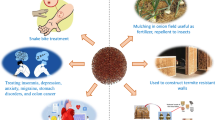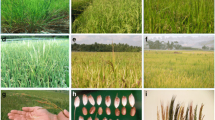Abstract
Archaeological studies of plant remains have indicated that an increase in seed size is frequently correlated with both intensive cultivation and domestication of seed crop plants. To test if starch granules of domesticated root crops are significantly larger than those of wild or less intensively cultivated plants, archaeological and modern specimens of manioc and sweet potato were sampled for starch granules, and granule size was compared across a temporal sequence. The results indicate that a gross generalization can be made that modern specimens of both manioc and sweet potato yield larger starch granules than some archaeological specimens. It does appear, however, that modern domesticated manioc roots produce significantly larger-sized starch granules than those of its purported wild ancestor. Additionally, there exist two lines of evidence that the coastal Peruvian and lowland Neotropical regional types of manioc differ from one another and have been separate for several millennia. These findings indicate that manioc may have been domesticated more than once.
Similar content being viewed by others
Literature Cited
Crawford, G. 1992. Prehistoric plant domestication in East Asia. Pages 7–38in C. W. Cowan and P. J. Watson, eds., The origins of agriculture: an international perspective. Smithsonian Institution Press, Washington, D.C.
Fregene, M. A., J. Vargas, J. Ikea, F. Angel, J. Toh-me, R. A. Asiedu, M. O. Akoroda, and W. M. Roca. 1994. Variability of chloroplast DNA and nuclear ribosomal DNA in cassava (Manihot es-culenta Crantz) and its wild relatives. Theoretical and Applied Genetics 89:719–727.
Hoffman, S. D. 1993. Subsistence in transition: indigenous agriculture in Amazonas, Venezuela. Doctoral dissertation, University of California, Berkeley.
Jones, V. H. 1936. The vegetal remains of Newt Kash Hollow Shelter. Pages 147–167in W. S. Webb and W. D. Funkhouser, eds., Rock shelters in Menifee County, Kentucky. University of Kentucky Reports in Archaeology and Anthropology 3.
Matsuzawa, T. 1978. The formative site of Las Haldas, Peru: architecture, chronology, and economy. American Antiquity 43:652–672.
McClung de Tapia, E. 1992. The origins of agriculture in Mesoamerica and Central America. Pages 143–171in C. W. Cowan and P. J. Watson, eds., The origins of agriculture: an international perspective.
Miller, N. F. 1992. The origins of plant cultivation in the Near East. Pages 39–58in C. W. Cowan and P. J. Watson, eds., The origins of agriculture: an international perspective.
Olsen, K. M., and B. A. Schaal. 1999. Evidence on the origin of cassava: Phylogeography ofManihot esculenta. Proceedings of the National Academy of Science 96:5586–5591.
Pearsall, D. M. 1992. The origins of plant cultivation in South America.In C. W. Cowan and P. J. Watson, eds., The origins of agriculture: an international perspective. Smithsonian Institution Press, Washington, D.C.
Piperno, D. R., and I. Hoist. 1998. The Presence of starch grains on prehistoric stone tools from the humid neotropics: indications of early tuber use and agriculture in Panama. Journal of Archaeological Science 25(8):765–776.
Piperno, D. R., A. J. Ranere, I. Hoist, and P. Han-sell. 2000. Starch grains reveal early root crop horticulture in the Panamanian tropical forest. Nature 407:894–897.
Rogers, D. J., and H. S. Fleming. 1973. A monograph ofManihot esculenta with an explanation of the taximetric methods used. Economic Botany 27: 1–113.
Smith, B. D. 1995. The emergence of agriculture. Scientific American Library, New York.
Toothaker, L. E. 1993. Multiple comparison procedures. Sage Publications, Newbury Park.
Ugent, D., S. Pozorski, and T. Pozorski. 1981. Prehistoric remains of the sweet potato from the Casma Valley of Peru. Phytologia 49(5):401–415.
—, 1982. Archaeological potato tuber remains from the Casma Valley of Peru. Economic Botany 36(2):182–192.
—. 1986. Archaeological manioc (Manihot) from coastal Peru. Economic Botany 40(1):78–102.
—,and M. Verdun. 1983. Starch grains of the wild and cultivated Mexican species ofSolanum, Subsection Potatoe. Phytologia 53(5):351–363.
Yarnell, R. A. 1972.Iva annua var.macrocarpa: Extinct American cultigen? American Anthropologist 74:335–341.
—. 1978. Domestication of sunflower and sump-weed in eastern North America. Pages 285–299in R. Ford, ed., The nature and status of ethnobotany. Anthropological Papers No. 67, Museum of Anthropology, University of Michigan, Ann Arbor.
Author information
Authors and Affiliations
Rights and permissions
About this article
Cite this article
Perry, L. Starch granule size and the domestication of manioc (Manihot esculenta) and sweet potato (Ipomoea batatas). Econ Bot 56, 335–349 (2002). https://doi.org/10.1663/0013-0001(2002)056[0335:SGSATD]2.0.CO;2
Received:
Accepted:
Issue Date:
DOI: https://doi.org/10.1663/0013-0001(2002)056[0335:SGSATD]2.0.CO;2




